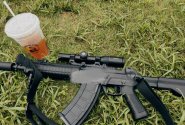This is a little bit off topic, but seeing as it does relate to the QBZ-191 it is worth talking about it.
The main reason I am talking about it is as the last two Pages have included the comparison to the NGSW. I am and was trying to clarify why they ended up seeing what we see with it and how two weapons under development at the same time period can be so similar and so divergent.
The QBZ-95 was a rifle designed at the time when the PLA wanted a compact, reliable enough rifle that could be mass issued for mechanized forces, at a time when mechanization was still very much a work in progress for the PLA.
The ability for infantry to add on additional accessories and optics was very much not a focus, nor longer term modularity.
The QBZ95 was a product of its time and a rushed one at that. The PLA wanted a “modern” rifle to give the troops for the Hong Kong hand over parade. We know as a result of that the it suffered poor ergonomics on its selector, issues of optics rail mount being out of spec to the proprietary optic, poor performance of the 5.8x42mm rifle ammunition. These lead to the QBZ95-1. They also clearly wanted a family of weapons else why have the QBZ95 carbine and QBB95 LMG? Even farther the Export 5.56x45mm versions. It was “modular” to a degree just not to the degree of say G36.
am The high sight mount was actually a norm on Bullpups of the 80s to mid 1990s Famas, AUG, SAR21 both feature it. Even CAR15s and AR15s of the time used handle mounted optics when so configured the British Susat optics were probably the lowest of mounts at the time and even those stand pretty tall by modern standards. G36 was State of the art in 07 popular in all your favorite games and movies in its German configuration has an optic mount for two scopes one over the other that sits very high.
Aftermarket upgrades for the QBZ-95 (including some in use with the PLA and PAP) today do offer the ability to install additional accessories, optics and including night fighting capabilities exist and appear fairly viable to me, but obviously the PLA wanted something that was more modern and could be adopted longer term, without needing the same barrel length to achieve bullet characteristics which in the past needed a long barrel which in turn needed a bullpup design for mechanization compatibility. And it has the design features needed for a modern rifle to allow upgrades and compatibility with accessories with relative ease, and not have a crazy high sight over bore.
The PLA I think realized the modifications hit the growth potential for the QBZ95 to fast. The last 30 years really raced by. The Bullpup trend has ended and ended hard.
The NGSW for the US Army, in my view, still very much has a question mark over it. While a very capable rifle, in context of the missions that the US Army and the US military will be facing into the near future and next few decades, I think it is a genuine question as to whether the additional weight, and reduced magazine size and reduced magazine count per soldier capacity, of a 6.8mm rifle is significant enough to be fielded as a standard service rifle, rather than something more limited like a DMR or maybe a GPMG replacement.
Again we now have weapon families that were in development in the same timeframe but results are dramatically different. Those aspects being the result of practical considerations and doctrines.
The Increased heft in XM7 isn’t just just the rifle but the package. The base rifle is only 8 ounces heavier than M27 another over built rifle. But then you add the Ammunition. Then the Suppressor and the Optic. Because that’s how NGSWR is supposed to be issued. It’s expected that fully loaded XM7 is probably just edging 13 pounds.
If QBZ191 was issued the same way it would be a heavyweight as well. We don’t have a firm weight yet on the Type 191 but 7.8 loaded is about the norm for a intermediate cartridge rifle not pulling automatic rifle double duty or firing Fury. Then we add a can that’s another 1.2 pounds, then a 2 pound optic that’s easily 11 pounds.
The M250 has similar packaging that pushes its weight higher. A 13 pound LMG empty with Bipod is impressive vs it’s predecessor is 17 pounds. It’s not as light as the given 11 lbs of the QYJ201 but again if the two were packed out the same way.
Magazine capacity is one of those practical issues where Doctrine has to bow to logistic and human considerations. In Both the QBZ191 and XM7 they used as their basis off the shelf magazines. In both cases they made choices that are really similar.
In the QBZ191 it’s basically just updated It’s the same basic magazine as the QBZ95/QBZ03/QST11. Which is why the magazine release is AK style because that was what the Designers of the previous rifles used. It’s logical as it means that they have commonality with older stocks, older web gear and the new rifle is still using 5.8x42mm cartridge family. So why rock the boat?
XM7 uses a SR25 based off the shelf 20 round polymer magazine. This was chosen first as it’s easily sourced, second as the Army’s existing web gear includes magazine pouches that were designed for just that type via the M110. The 6.8 fury ammunition coul easily be loaded into 25 round magazines (again off the shelf commercially available) it’s just the Army would have to field pouches (They exist just not in Army inventory) that fit those. Beyond that it’s just too big. Again Why rock the boat? Magazine number is a weight and size consideration. Not unique to the NGSW as troops carrying additional weapons or DMR rifles often trade off some magazines.
DMR vs Universal cartridges. In WW2 a DMR and a sniper rifle were both more or less the same. An infantry rifle modified to take a by modern standards low power scope. When the Soviets introduced the AK series they realized that the 7.62x39mm cartridge left much to be desired with range. So they kept fielding Mosins as DMRs. In the west at that point NATO was starting to move to the Battle rifle and the US was Pushing 7.62x51mm an improved 30.06 cartridge. In about 63 the Soviets introduced the Dragonov. The Chinese got it as the type 79. The Older model of DMR doctrine was that your Marksman was still using the same rifle or one he has trained on already and the same ammunition.
the Ak broke this So the Marksman became for the Soviets a specialist he was at the Platoon level and only shared ammunition with the PK gunner as the Soviet squads moved to RPKs.
The PLA when it started it’s intermediate caliber development that would lead to the 5.8x42mm tried to resolve this by making everyone fire more or less the same ammunition.
This is similar to what NATO has tried with 7.62x51mm and 5.56x45mm.
7.62x51mm offered punch and range but was heavy and uncontrollable in full auto from rifles unsupported.
5.56x45mm NATO could be controlled it’s very accurate and has fair range. So they built what were supposed to be GPMGs but ended up as LMGs. They mounted scopes on M16s and found them short on range and weak on power.
Because Intermediate caliber live and die inside the 500m bubble. Well Full power rifle cartridges are just that full power.
So NATO had to compromise and adopt back in GPMG and DMRs but it meant you now had infantry who were not able to trade ammo and weapons far heavier the. The rest of their units. Specialist who were put at the platoon level or who were very selective in employment as you don’t want to waste the headache where you didn’t have to. Leading to the modern disposition.
The Chinese kept at it first with the QBU88 though more recently the QBU191 seems to show that they have decided that the added cost and logistics of the dedicated Marksman rifle design isn’t worth it. leading to just a scoped long barrel rifle.
This leads us to why they are what they are.
6.8x51mm is targeted as a universal infantry caliber. It’s meant to take advantage of the technologies of the modern age so that you don’t need a DMR because everyone rifleman or Machine gunner is a marksman. That’s why it is the way it is.
A more specialized take on the universal cartridge the 5.8x42mm lives and dies on the hill of. A common cartridge for your Riflemen, team leader, automatic riflemen, machine gunners, DMs and more.
The difference is that rather than being army wide 6.8x51mm will be selective in pushing to the Infantry whom are specialists of pulling triggers. Well support troops retain 5.56x45mm.
Well the QBZ191 and it’s family is being targeted to replace Everything. Trigger pullers to Cooks. Resulting in different solutions and outcomes.
The Doctrines pushing these are rooted in their respective armies and what they view as it’s position on modernization.



